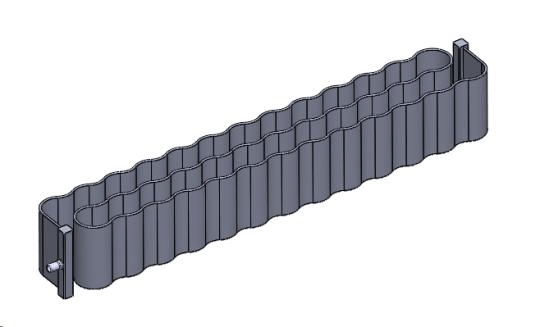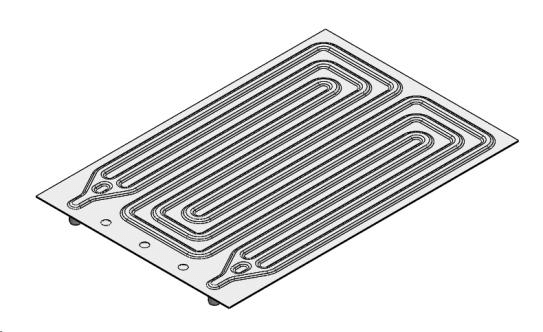신에너지 분야에서 냉각판의 적용에 대해 이미 어느 정도 알고 있을 수도 있습니다. 하지만 냉각판에 대한 깊은 이해가 없으면 부적합한 유형을 선택하거나 설계하여 프로젝트가 지연될 수 있습니다. 유럽의 한 신에너지 차량 고객과 함께 일한 적이 있는데, 처음에 부적합한 유형의 액체 냉각판을 선택해 나중에 유형을 변경해야 할 때 상당한 지연이 발생했습니다. 그렇다면 새로운 에너지 분야에서 사용되는 냉각판의 주요 유형은 무엇일까요?
액체 냉각판의 주요 유형을 아는 것은 시작에 불과합니다. 이러한 냉각판은 배터리 팩 시스템의 열 관리에서 중요한 역할을 하며 복잡한 기술적 세부 사항을 포함합니다. 올바른 냉각판을 선택하거나 설계하려면 더 깊은 이해가 필요합니다. 함께 계속 읽어보세요.
냉각판은 액체 냉각 시스템의 중요한 부분입니다. 열전도율이 뛰어나 배터리 모듈이나 팩에서 발생하는 열을 효과적으로 흡수하고 전달합니다. 냉각수는 냉각판 내부의 튜브를 통해 흐르며 열을 효율적으로 제거합니다. 이러한 직접적인 열 전도 및 전달 메커니즘 덕분에 콜드 플레이트는 배터리 온도 관리에 필수적인 역할을 합니다.
데이터센터에서는 전력 밀도가 높기 때문에 효과적인 냉각이 매우 중요합니다. 특히 냉각판 시스템을 사용하는 액체 냉각은 내부 구성 요소에서 외부로 열을 효율적으로 전달합니다. 이 방식은 안전한 작동 온도를 보장하고 냉각수와 민감한 전자기기가 직접 접촉하는 것을 방지합니다. 또한 CPU와 메모리와 같은 주요 구성 요소에 정밀한 열 교환을 제공합니다.
(열 교환기는 액체 냉각 판형 열 교환기입니다.)

원통형 배터리의 경우 거의 모든 고객이 Tesla 원통형 배터리 열교환 케이스와 같이 뱀 모양의 튜브가 있는 측면 열교환 솔루션을 사용합니다. (사문석 튜브 지침)
프리즘 배터리의 경우 73.3%의 고객이 바닥 열교환이 가능한 액체 냉각판을 선택합니다. 최근에는 측면 열교환 또는 다면 열교환을 사용하는 경우도 점점 더 많아지고 있습니다. 측면 열교환은 마이크로 채널 튜브를 압출하여 구부리는 방식으로, 뱀 모양 튜브와 유사합니다. 그리고 그림 3에 표시된 다면 열교환은 바닥과 측면을 동시에 냉각하여 효율을 크게 향상시킵니다. (콜드 플레이트 지침)



하이드로포밍 기술은 복잡하면서도 정밀한 모양을 만드는 스탬핑 공정의 일종인 하이드로포밍 기술을 활용합니다. 배터리 온도를 효과적으로 제어하고 배터리 간 온도 차이를 최소화하는 액체 냉각판 생산에 이상적입니다.
정밀한 모양: 복잡한 기하학적 모양을 생성하여 열 전달 및 냉각 효율을 최적화합니다.
내구성: 견고하고 높은 압력과 온도에 강한 구조로 열악한 환경에 적합합니다.
적응성: 다양한 장비 크기에 맞게 유연하게 설계할 수 있습니다.
효율성: 짧은 생산 주기로 수요에 맞춰 빠르게 대량 생산할 수 있습니다.
알루미늄 잉곳은 여러 금속 스트림으로 압력을 가해 금형 틈새를 통해 평면 또는 마이크로 채널 튜브를 형성합니다. 이를 통해 냉각판의 모양과 크기를 정밀하게 제어하여 부하 용량을 향상시킬 수 있습니다.
효율성과 비용 효율성: 알루미늄 압출에 사용되는 간단한 금형은 생산 주기를 단축하고 비용을 절감합니다.
마찰 교반 용접(FSW)은 빠르게 회전하는 바늘 모양의 도구를 사용하여 두 금속 공작물을 녹이지 않고 마찰적으로 가열하고 부드럽게 만드는 고체 공정입니다. 그런 다음 재료를 소성 변형하고 혼합하여 용접을 만듭니다.
높은 강도: FSW는 원래 금속의 70% 이상의 강도를 유지하며 견고한 용접을 제공합니다. 용접 후 샌딩으로 매끄러운 마감을 구현할 수 있습니다.
일관된 처리: 특수 툴링과 교반 바늘로 작업물 전체에 균일성을 보장합니다.
이 방법은 블록에서 특정 모양과 내부 채널을 조각하여 냉각 유체가 흐를 수 있도록 가공하는 방법입니다. 극한의 조건에서 부품의 안정성과 내구성을 보장합니다.
고도로 맞춤화 가능: 가공 기술을 통해 특정 모양과 크기에 맞춘 수냉식 패널을 제작할 수 있어 다양한 애플리케이션의 고유한 요구 사항을 충족할 수 있습니다.
내구성: 기계 가공된 냉각판은 기계적 특성이 강하고 마모와 부식에 강해 수명이 길어지고 교체 빈도가 줄어들며 장기적인 비용과 유지 관리가 절감됩니다.

액체 냉각판이 안정적인 열전도율을 갖도록 하기 위해 액체 냉각판 표면에 열 인터페이스 소재를 더 자주 설치합니다. 열 인터페이스 재료는 안정적인 열 전도 효율을 가지며 배터리와 액체 냉판 사이의 접촉 면적을 증가시킵니다. 대부분의 열 인터페이스 재료에는 약간의 단열재와 실리콘 패드(주요 열 인터페이스 재료 중 하나)는 일반적으로 3~7Kv의 전압 저항을 달성할 수 있습니다.
가장 효율적인 배터리 열 관리 솔루션 중 하나인 수냉식 냉각판의 기술 혁신은 다음과 같은 주요 영역에 초점을 맞출 수 있습니다:
1. 소재 혁신: 그래핀이나 복합 소재를 사용하는 등 새로운 소재를 개발하거나 기존 소재를 개선하여 열전도율을 높이면서 무게와 비용을 줄입니다. 이를 통해 냉각판의 효율을 높여 더 높은 방열 수요를 충족할 수 있습니다.
2. 마이크로채널 기술: 제품 내부 채널을 더 작게 설계하여 냉각수의 표면적을 넓혀 열 교환 효율을 개선합니다. 이를 통해 열을 더 빠르게 흡수하고 방출할 수 있습니다.
3. 모듈식 및 확장형 설계: 다양한 용도에 맞게 쉽게 확장하거나 수정할 수 있는 모듈식 냉각판 시스템을 구축하여 설계 및 생산 비용을 절감하고 잠재적 사용 범위를 넓혔습니다.
제 대답은: 예, 저는 액체 냉각판을 최적화하는 데 있어 인공지능의 역할에 대해 매우 낙관적으로 생각합니다. 현재 액체 냉각판의 설계는 다양한 도구를 사용하여 액체 냉각판의 효과를 테스트, 시뮬레이션 및 검증합니다. 도면 검토 및 교정에는 인력과 물적 자원이 필요하며, 작업 조건을 판단하는 현재의 컴퓨터 시뮬레이션 시스템은 여전히 상대적으로 시간이 많이 걸리는 상태입니다. 향후에는 일부 기본적이고 반복 가능하며 계산 가능한 표준 작업은 AI가 수행할 수 있습니다.
산업 생산에서 AI는 냉각판 모양, 내부 냉각 채널 구성, 핀 형상, 입구 및 출구 위치 등의 최적화 설계에서 보다 효율적이고 타깃화된 솔루션을 제공하여 일부 기존 방식의 한계를 극복할 수 있습니다.
새로운 에너지 분야에서 액체 냉각판 적용의 핵심은 시스템의 열 관리 효율을 개선하는 것입니다. 이 기사가 프로젝트 요구 사항을 충족하기 위해 어떤 종류의 액체 냉각판을 선택할 수 있는지 이해하는 데 도움이 될 수 있다고 생각합니다. 앞으로 인공 지능의 개입은 설계 최적화의 무한한 가능성을 예고합니다. 냉각판 기술은 엔지니어의 도전 과제일 뿐만 아니라 새로운 에너지 분야 전체의 미래 발전을 위한 노력이라고 할 수 있습니다.

저는 5년 넘게 배터리 열 관리 분야에서 일하면서 수많은 국제 프로젝트를 처리했습니다. 배터리 액체 냉각 제품이나 서비스에 대해 궁금한 점이 있으면 언제든지 문의해 주세요!